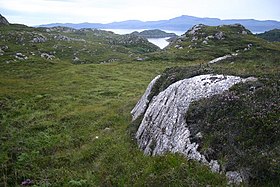Basement (geology)
Crustal rocks are modified several times before they become basement,[clarification needed] and these transitions alter their composition.The sedimentary rocks which may be deposited on top of the basement usually form a relatively thin veneer, but can be more than 5 kilometres (3 mi) thick.They may also contain ophiolites, which are fragments of oceanic crust that became wedged between plates when a terrane was accreted to the edge of the continent.The majority of continental crust on the planet is around 1 to 3 billion years old, and it is theorised that there was at least one period of rapid expansion and accretion to the continents during the Precambrian.Eventually, the subduction of the underthrusting oceanic crust can bring the volcanic arc close to a continent, with which it may collide.[citation needed] In Andean geology the basement refers to the Proterozoic, Paleozoic and early Mesozoic (Triassic to Jurassic) rock units as the basement to the late Mesozoic and Cenozoic Andean sequences developed following the onset of subduction along the western margin of the South American Plate.[7] When discussing the Trans-Mexican Volcanic Belt of Mexico the basement include Proterozoic, Paleozoic and Mesozoic age rocks for the Oaxaquia, the Mixteco and the Guerrero terranes respectively.
GneissoutcropScotlandgeologysedimentaryplatformsedimentary rockssedimentary basinsmetamorphicigneoussedimentsigneous rockcontinentsgranitesandstonelimestoneGrand CanyonschistVishnu Schistbasaltsubductionoceanic riftingcrystallineophiolitesoceanic crustterraneunderplatingcontinental crustEarth's mantlevolcanismvolcanic arcmetamorphismigneous intrusionsextrusive igneous rockaccretedterranesexotic terranescratonsPangeasupercontinentEuropean geologyVariscan orogenyPermianevaporitesMesozoiclimestonesAndeanProterozoicPaleozoicTriassicJurassicCenozoicSouth American PlateTrans-Mexican Volcanic BeltMexicobasin geologysedimentologypetroleum geologyPrecambrianpetroleumnatural gasShieldBedrockUnited States Geological SurveyBibcode
